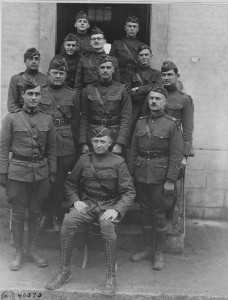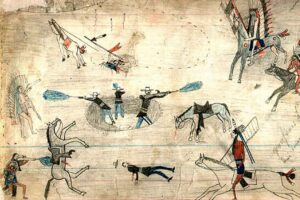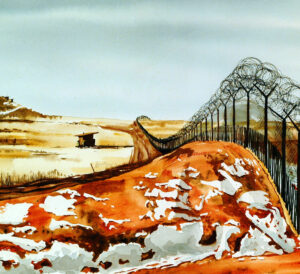by Terrance McGovern
Fort Wool has played an important role in America’s history, yet even the fort’s current existence has faded from America’s memory. Known as Fort Calhoun until 1862, Fort Wool is a historic fortification at the confluence of Hampton Roads and the Chesapeake Bay located on Willoughby Shoal, constructed between 1819 and 1867 (it was never completed), and placed on the National Register of Historic Places and the Virginia Landmarks Register in 1969.

Fort Wool and nearby Fort Monroe were built in the aftermath of the War of 1812, powerful symbols of American liberty and independence. Robert E. Lee, Andrew Jackson, and Abraham Lincoln shaped the history of Fort Wool. The fort took part in the famous naval battle between the ironclads CSS Virginia and USS Monitor during the Civil War. Forts Wool and Monroe were designed to work together in defending Hampton Roads from naval attack, and during the Civil War they were both gateways for contrabands (escaping slaves seeking freedom), including Sheppard Mallory, who labored at Fort Wool for the Union forces.

Fort Wool had been a publicly accessible park for more than thirty-five years as a wonderful example of American coast defenses, and it was one of Hampton’s top tourist attractions, generating economic value and employment for many years. In 2020, the Commonwealth of Virginia closed the island to the public to use it as a temporary seabird nesting habitat to due the impact of the expansion of the Hampton Roads Bridge-Tunnel. Fort Wool remains closed to tourists even when the seabirds are not nesting (September to March). Efforts are underway by the Coalition for Historic Fort Wool and the City of Hampton to convince the Commonwealth to restore the island and relocate the nesting area to a newly created habitat.
In 1816, the Board of Engineers for Fortifications, a committee of Army officers, met to develop a plan for national defense. The board, headed by Brigadier General Simon Bernard (an expatriate Frenchman who had served as a general of engineers under Napoleon), developed a plan to build more than forty new coastal forts, including Fort Calhoun, the forerunner of Fort Wool. Designed by Bernard, the fort was to have three tiers of casemates and a barbette tier which would allow for a total of 232 muzzle-loading cannon to be mounted, and it was to be manned by a garrison of about 1,000 soldiers. With four tiers, it was planned as the first “tower fort” of the Third System, resembling the four-tier Castle Williams, a Second System fort in New York Harbor. Early plans called it “Castle Calhoun,” after then-Secretary of War John C. Calhoun. The fort was effectively a sea fort, as the island had to be built up considerably to accommodate it. The fort was planned as a shallow “V” shape pointing north, with rounded ends. It was to be built on a fifteen-acre artificial island southeast of Old Point Comfort in Hampton, on the other side of the shipping channel from Fort Monroe.
Construction began in 1819 when workers started dumping granite boulders into the water. It took four years to bring the rock pile up to the six-foot-tall island called for in the plans, and three more years before the foundation was ready to begin the fort’s construction.
Construction of the fort itself began in 1826, and after considerable delays caused by subsidence of the island, two-thirds of the first level of casemates was finally completed in 1830. Construction continued through 1834, and only half of the second tier was completed. It was then found that Fort Calhoun’s foundations had continued settling. Reports to the Chief of Engineers repeatedly stated that the island had stabilized and construction could continue “the next year.” The island, however, never fully stabilized, and it continues to settle to this day.

A young Army second lieutenant and engineer, Robert E. Lee, was transferred there to assist Captain Andrew Talcott, the engineer in charge of the construction of Fort Wool and its larger companion Fort Monroe, across the channel on the mainland. Lee was given the task of stabilizing the island as his first independent command. He found that the island would not hold the weight of the two tiers of casemates and brought more stone in to stabilize it, but the fort never reached its intended size. Lee found the stone foundation under the fort was the problem and that it could not support the weight of the four tiers of the completed fort.
Work on the structure began again in 1858, but the outbreak of the Civil War in 1861 brought the fort’s construction to a halt, with one complete tier and one open-top tier of casemates on about two-thirds of the designed perimeter. The south-facing “gorge” or back of the fort remained open (the side of the fort facing away from the shipping channel).

In 1829, during the first summer of his presidency, Andrew Jackson went on an inspection tour of several military projects around Norfolk, Virginia. One of the places he visited was Fort Calhoun. Jackson had heard much about the fort in the years before he became President due to a War Department scandal regarding the contract for its construction. Jackson, and many others, called the place the Rip Raps or Rip Rap Shoals instead of Fort Calhoun, deriving the name from the rip rap stone which comprised the island.
Jackson was so taken with the place that a few weeks after the official visit he returned from Washington with his Tennessee friend and Secretary of War John Henry Eaton. The men stayed for ten days. The President staying for a lengthy visit on an isolated and unattractive island with little company raised concerns for many observers. There appeared to be some anxiety that he was purposely staying on the barren island in order to hide the true condition of his health. Jackson’s purpose for staying on the island was likely for solitude and privacy. After the visit, he reported to another friend, James Alexander Hamilton, that “the fine air & pleasant bath” steadied his health. Jackson returned to Fort Calhoun three more times—in 1831, 1833, and 1835—all of the summers of his presidency that he did not make the trip home to The Hermitage in Tennessee. Health was a big reason for his trips, not to keep his condition secret, but rather to gain some rest and rejuvenation. Since Jackson’s health was always a constant vexation, there was no reason to go into seclusion as his critics had claimed. Scores of letters from Jackson, written at Fort Calhoun, confirmed he spent his time pondering and confronting the greatest questions of the time, including the Peggy Eaton Affair, the Bank War, the annexation of Texas, and the tragic removal of Indian tribes from their native lands.
At Fort Calhoun, the Jackson entourage occupied the officers’ quarters, a newly built two-story wooden building with a porch across the second, or main floor. Their food was provided by the Hygeia Hotel across the way at Fort Monroe. Fort Calhoun proved for four summers to be the place where Andrew Jackson unwound, sought health, and breathed in the refreshing sea air at the fort. He never returned after the 1835 stay nor did he ever spend time at any other seaside location.
President John Tyler took sanctuary on Fort Calhoun after the death of his first wife in 1842. He returned in 1844 for a month-long honeymoon with his new wife, Julia Gardiner. The quarters at Fort Calhoun where Presidents Jackson and Tyler had lived burned in 1846 and were not replaced.

The fort was originally named after John C. Calhoun, President Monroe’s Secretary of War who was a Southern politician of secessionist tendencies. In 1862, it was renamed after Major General John Ellis Wool, a Mexican War hero and commander at Fort Monroe. Fort Wool was armed during the Civil War, initially with only ten guns, and fired on Confederate positions and vessels as needed.
A long-range, experimental cannon, the Sawyer gun, was installed at Fort Calhoun/Wool in mid-1861 during the Civil War. The weapon was a rifled 24-pounder, and an illustration in an August 1861 newspaper shows it mounted on a high-angle carriage. The range of this weapon extended to Sewell’s Point, more than three miles away (where Naval Station Norfolk is now located) and the site of a Confederate earthen fort with bastions, a redan, and three artillery batteries totaling forty-five guns. The Sawyer gun was one of several rifled artillery pieces developed by Sylvanus Sawyer, but none of his designs were widely adopted. During the Civil War, the garrison at Fort Wool witnessed the Battle of Hampton Roads, which took place off Sewell’s Point on 8-9 March 1862, and saw the USS Monitor clash with the CSS Virginia. During the battle, soldiers from Fort Wool fired their Sawyer gun at the Virginia but did no damage to the ironclad’s armor.
In late October 1861, six months after the outbreak of the Civil War, eleven enslaved men seeking liberty arrived at Fort Calhoun and reported all they knew about the Rebel works Sewell’s Point, providing important intelligence for the region’s defenders. They were part of a steady stream of African Americans arriving in the region since Major General Benjamin F. Butler’s so-called Contraband Decision that spring. This arrival at Fort Calhoun was the first of many enslaved that would use the fort as their pathway to freedom.

In early May 1862, President Abraham Lincoln came to Fort Monroe to plan the offensive movement against Norfolk and took a tugboat to Fort Wool for a close look at the Rebel fortifications at Sewell’s Point. Thirty years after Jackson railed against South Carolina’s threat of secession from this rocky island, Lincoln personally ordered the firing of the Sawyer rifle in a war for the preservation of the Union.
Lincoln used Fort Wool to watch the Federal fleet’s offensive movement. He was joined by Secretary of Treasury Salmon P. Chase and Secretary of War Edwin M. Stanton, the latter of whom telegraphed that “The President is at this moment at Fort Wool witnessing our gunboats…The Sawyer Gun in Fort Wool has silenced one battery on Sewell’s Point. The James Rifle mounted on Fort Wool also does good work. It was a beautiful sight to witness the boats moving on to Sewell’s Point, and one after another opening fire and blazing away every minute.”
In 1885, the Endicott Board met to recommend improvements to U.S. coast defenses. At Fort Wool, the result was the demolition of all but a small part of the western end of the fort to make room for modern gun emplacements. The Army proceeded to construct five batteries at Fort Wool between 1902 and 1908. Four of the batteries were built as the main gun line facing north and the fifth battery faced south. This construction cut down the granite fort to one tier. The Army then built the concrete batteries into the masonry fort, except on the western end of the island where Third System casemates remain. Fort Wool was armed with relatively small-caliber, rapid-fire guns that focused on the shipping channel directly in front of the fort, while Fort Monroe had numerous large-caliber weapons. The 3-inch guns were intended to defend controlled underwater minefields against minesweepers and fast-moving torpedo boats. Some of the controlled mines were stored at Fort Wool but controlled from Fort Monroe. Supporting these gun batteries were searchlights on towers, a fort commander’s tower, barracks, a bathhouse, and a mess hall. The following batteries were built and named:
Name, Number/Size Carriages, Years in Operation
Battery Ferdinand Claiborne: Two 6-inch M1903 guns on M1903 disappearing carriages (1908-18)
Battery Alexander Dyer: Two 6-inch M1903 guns on M1903 disappearing carriages (1908-17)
Battery Horatio Gates: Two 6-inch M1903 guns on M1903 disappearing carriages (1908-42)
Battery Henry Lee Four: 3-inch rapid-fire M1902 guns on M1902 pedestal (1905-43)
Battery Jacob Hindman: Two 3-inch rapid-fire M1902 guns on M1902 pedestal (1905-46)

Fort Wool was garrisoned during World War I, but the war in Europe caused a shift in armament. Battery Dyer and Battery Gates had their gun tubes shipped overseas in 1917 and 1918. The gun tubes in Battery Claiborne were shifted to Battery Gates. Battery Claiborne and Battery Dyer remained unarmed from then on. A coincidence rangefinder (CRF) station for Battery Gates was built on top of Battery Dyer’s magazine in 1921. Antisubmarine nets were stretched across the harbor between Fort Wool and Fort Monroe in both World Wars.
Fort Wool was garrisoned during World War II, but all of the remaining armament was obsolete and construction began on a new 200 Series battery in 1943. The Army removed the obsolete guns by 1943 except for the two 3-inch guns in Battery Hindman. The new Battery Construction #229 was built from March 1943 to January 1944. The work was completed, and the shielded carriages were installed; however, the gun tubes were not mounted. Several temporary World War II structures were built to provide quarters and support for the gun crews.
The construction of Battery #229 with two 6-inch shielded guns on long-range carriages resulted in the Endicott emplacement for Battery Gates being all but destroyed, with its 6-inch guns on disappearing carriages scrapped. This new battery was made of reinforced concrete and became known as Battery Gates as well. The uniquely designed emplacement had the power room, plotting switchboard room, magazines, and other protected rooms on one level while the two 6-inch guns were one level up. This caused ammunition service to be up a flight of stairs instead of using carts on one level. As part of the Battery Gates, the Army constructed a steel tower that had both a Battery Commander’s and CRF stations mounted on top.

On 30 Sep 1943, an SCR-296A Radar set installation was accepted for service to provide radar fire control for the yet-to-be-completed Battery 229. The location of the radar set was on the west end of the island just outside the fort’s walls on a steel tower, with its power equipment and operating room inside the 3rd System casemates. Also, a battery commander station with a CRF instrument on its roof was built on top of the Third System casemates to support the two 3-inch guns at Battery Hindman.
Battery Lee’s four 3-inch guns were transferred, two each in 1942 to Fort Story and Fort John Custis on Fisherman Island. Antisubmarine nets were stretched across the harbor between Fort Wool and Fort Monroe in both World Wars. In 1946, the Army transferred Battery Hindman’s pair of 3-inch guns to Fort Monroe as a salute battery.
After World War II, the Army placed Fort Wool on caretaker status until it was decommissioned in 1953; it was turned over to the Commonwealth of Virginia in 1967. In the 1950s, the Hampton Roads Bridge-Tunnel (HRBT) was constructed next to Fort Wool, with its southern island connected to the fort by an earthen and rock causeway. In 1985, the City of Hampton leased the island from the Commonwealth to provide daily tours to the historic fort via a tour boat. Thousands of visitors (typically 8,000 per season) safely visited and enjoyed Fort Wool every year. This lease was terminated in March 2020 and the fort was closed to the public. Fort Wool can also be seen by westbound vehicles on approach to the HRBT southern tunnel, which carries Interstate 64 across the mouth of Hampton Roads.

The nearby construction of the HRBT Expansion Project resulted in the displacement of a seasonal nesting habitat seabirds, which has long been located on South Island. As a result of the construction impacts, the adjacent Fort Wool was converted in the spring of 2020 into a much smaller temporary substitute nesting location for the seabirds. This conversion involved dumping tons of sand and gravel on the Fort, removing historic markers and granite blocks, and excluding public access. The public ferry service from Hampton has been discontinued. The Commonwealth is considering demolishing the historic and rare World War II-era battery commander tower on the island. In May 2021, Historic Fort Wool was designated as one of Virginia’s Most Endangered Historic Places by Preservation Virginia. Continued bird use threatens the preservation of Fort Wool by deferring important maintenance and repairs, while at the same time excluding the public from visiting the historic fort, an important piece of the defenses of Chesapeake Bay and Hampton Roads.
About the Author
Terrance (Terry) McGovern has authored eight books and numerous articles on fortifications, four of those books being for Osprey’s Fortress Series (American Defenses of Corregidor and Manila Bay 1898 1945; Defenses of Pearl Harbor and Oahu 1907-1950; American Coastal Defenses, 1885 1950; Defenses of Bermuda 1612-1995). He has also published fourteen books on coast defense and fortifications through Redoubt Press or Coast Defense Study Group (CDSG) Press. Terry was Chairman of the U.S.-based CDSG and continues to be a longtime officer. He has also been the editor of the Fortress Study Group annual journal, FORT. He is a director of the International Fortress Council and the Council on America s Military Past. He can be contacted at tcmcgovern@att.net.



